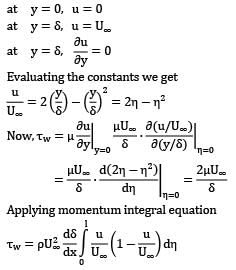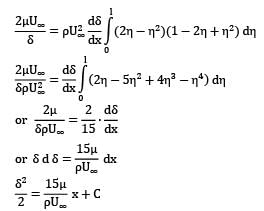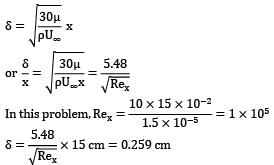Civil Engineering (CE) Exam > Civil Engineering (CE) Questions > Air moves over a flat plate with a uniform f...
Start Learning for Free
Air moves over a flat plate with a uniform free stream velocity of 10 m/s. At a position 15 cm away from the front edge of the plate, what is the boundary layer thickness? Use a parabolic profile in the boundary layer. For air, ν = 1.5 × 10−5 m2/s and ρ = 1.23 kg/m3. Give your answer in mm.
Correct answer is '2.5 to 2.7'. Can you explain this answer?
| FREE This question is part of | Download PDF Attempt this Test |
Verified Answer
Air moves over a flat plate with a uniform free stream velocity of 10...
Assume





View all questions of this test

The boundary conditions are

Applying momentum integral equation


It is assumed that at x = 0, δ = 0 which yields
C = 0. Thus,

In the proclaim, Rex = 


= 0.259 cm
or δ = 2.59 mm
Most Upvoted Answer
Air moves over a flat plate with a uniform free stream velocity of 10...
Calculation of Boundary Layer Thickness
Given data:
- Free stream velocity (u∞) = 10 m/s
- Distance from the front edge of the plate (x) = 15 cm = 0.15 m
- Kinematic viscosity of air (ν) = 1.5 × 10−5 m2/s
- Density of air (ρ) = 1.23 kg/m3
Step 1: Calculation of Reynolds number (Re)
Reynolds number is given by:
Re = (ρ*u∞*x)/ν
Substituting the values, we get:
Re = (1.23*10*0.15)/1.5×10^-5
Re = 12300
Step 2: Calculation of Boundary Layer Thickness (δ)
Boundary layer thickness is given by:
δ = (5*x)/(sqrt(Re))
Substituting the values, we get:
δ = (5*0.15)/(sqrt(12300))
δ = 0.0025 m = 2.5 mm (approx)
Therefore, the boundary layer thickness is estimated to be around 2.5 to 2.7 mm.
Given data:
- Free stream velocity (u∞) = 10 m/s
- Distance from the front edge of the plate (x) = 15 cm = 0.15 m
- Kinematic viscosity of air (ν) = 1.5 × 10−5 m2/s
- Density of air (ρ) = 1.23 kg/m3
Step 1: Calculation of Reynolds number (Re)
Reynolds number is given by:
Re = (ρ*u∞*x)/ν
Substituting the values, we get:
Re = (1.23*10*0.15)/1.5×10^-5
Re = 12300
Step 2: Calculation of Boundary Layer Thickness (δ)
Boundary layer thickness is given by:
δ = (5*x)/(sqrt(Re))
Substituting the values, we get:
δ = (5*0.15)/(sqrt(12300))
δ = 0.0025 m = 2.5 mm (approx)
Therefore, the boundary layer thickness is estimated to be around 2.5 to 2.7 mm.
Attention Civil Engineering (CE) Students!
To make sure you are not studying endlessly, EduRev has designed Civil Engineering (CE) study material, with Structured Courses, Videos, & Test Series. Plus get personalized analysis, doubt solving and improvement plans to achieve a great score in Civil Engineering (CE).

|
Explore Courses for Civil Engineering (CE) exam
|

|
Similar Civil Engineering (CE) Doubts
Air moves over a flat plate with a uniform free stream velocity of 10 m/s. At a position 15 cm away from the front edge of the plate, what is the boundary layer thickness? Use a parabolic profile in the boundary layer. For air, ν = 1.5 × 10−5 m2/s and ρ = 1.23 kg/m3. Give your answer in mm.Correct answer is '2.5 to 2.7'. Can you explain this answer?
Question Description
Air moves over a flat plate with a uniform free stream velocity of 10 m/s. At a position 15 cm away from the front edge of the plate, what is the boundary layer thickness? Use a parabolic profile in the boundary layer. For air, ν = 1.5 × 10−5 m2/s and ρ = 1.23 kg/m3. Give your answer in mm.Correct answer is '2.5 to 2.7'. Can you explain this answer? for Civil Engineering (CE) 2024 is part of Civil Engineering (CE) preparation. The Question and answers have been prepared according to the Civil Engineering (CE) exam syllabus. Information about Air moves over a flat plate with a uniform free stream velocity of 10 m/s. At a position 15 cm away from the front edge of the plate, what is the boundary layer thickness? Use a parabolic profile in the boundary layer. For air, ν = 1.5 × 10−5 m2/s and ρ = 1.23 kg/m3. Give your answer in mm.Correct answer is '2.5 to 2.7'. Can you explain this answer? covers all topics & solutions for Civil Engineering (CE) 2024 Exam. Find important definitions, questions, meanings, examples, exercises and tests below for Air moves over a flat plate with a uniform free stream velocity of 10 m/s. At a position 15 cm away from the front edge of the plate, what is the boundary layer thickness? Use a parabolic profile in the boundary layer. For air, ν = 1.5 × 10−5 m2/s and ρ = 1.23 kg/m3. Give your answer in mm.Correct answer is '2.5 to 2.7'. Can you explain this answer?.
Air moves over a flat plate with a uniform free stream velocity of 10 m/s. At a position 15 cm away from the front edge of the plate, what is the boundary layer thickness? Use a parabolic profile in the boundary layer. For air, ν = 1.5 × 10−5 m2/s and ρ = 1.23 kg/m3. Give your answer in mm.Correct answer is '2.5 to 2.7'. Can you explain this answer? for Civil Engineering (CE) 2024 is part of Civil Engineering (CE) preparation. The Question and answers have been prepared according to the Civil Engineering (CE) exam syllabus. Information about Air moves over a flat plate with a uniform free stream velocity of 10 m/s. At a position 15 cm away from the front edge of the plate, what is the boundary layer thickness? Use a parabolic profile in the boundary layer. For air, ν = 1.5 × 10−5 m2/s and ρ = 1.23 kg/m3. Give your answer in mm.Correct answer is '2.5 to 2.7'. Can you explain this answer? covers all topics & solutions for Civil Engineering (CE) 2024 Exam. Find important definitions, questions, meanings, examples, exercises and tests below for Air moves over a flat plate with a uniform free stream velocity of 10 m/s. At a position 15 cm away from the front edge of the plate, what is the boundary layer thickness? Use a parabolic profile in the boundary layer. For air, ν = 1.5 × 10−5 m2/s and ρ = 1.23 kg/m3. Give your answer in mm.Correct answer is '2.5 to 2.7'. Can you explain this answer?.
Solutions for Air moves over a flat plate with a uniform free stream velocity of 10 m/s. At a position 15 cm away from the front edge of the plate, what is the boundary layer thickness? Use a parabolic profile in the boundary layer. For air, ν = 1.5 × 10−5 m2/s and ρ = 1.23 kg/m3. Give your answer in mm.Correct answer is '2.5 to 2.7'. Can you explain this answer? in English & in Hindi are available as part of our courses for Civil Engineering (CE).
Download more important topics, notes, lectures and mock test series for Civil Engineering (CE) Exam by signing up for free.
Here you can find the meaning of Air moves over a flat plate with a uniform free stream velocity of 10 m/s. At a position 15 cm away from the front edge of the plate, what is the boundary layer thickness? Use a parabolic profile in the boundary layer. For air, ν = 1.5 × 10−5 m2/s and ρ = 1.23 kg/m3. Give your answer in mm.Correct answer is '2.5 to 2.7'. Can you explain this answer? defined & explained in the simplest way possible. Besides giving the explanation of
Air moves over a flat plate with a uniform free stream velocity of 10 m/s. At a position 15 cm away from the front edge of the plate, what is the boundary layer thickness? Use a parabolic profile in the boundary layer. For air, ν = 1.5 × 10−5 m2/s and ρ = 1.23 kg/m3. Give your answer in mm.Correct answer is '2.5 to 2.7'. Can you explain this answer?, a detailed solution for Air moves over a flat plate with a uniform free stream velocity of 10 m/s. At a position 15 cm away from the front edge of the plate, what is the boundary layer thickness? Use a parabolic profile in the boundary layer. For air, ν = 1.5 × 10−5 m2/s and ρ = 1.23 kg/m3. Give your answer in mm.Correct answer is '2.5 to 2.7'. Can you explain this answer? has been provided alongside types of Air moves over a flat plate with a uniform free stream velocity of 10 m/s. At a position 15 cm away from the front edge of the plate, what is the boundary layer thickness? Use a parabolic profile in the boundary layer. For air, ν = 1.5 × 10−5 m2/s and ρ = 1.23 kg/m3. Give your answer in mm.Correct answer is '2.5 to 2.7'. Can you explain this answer? theory, EduRev gives you an
ample number of questions to practice Air moves over a flat plate with a uniform free stream velocity of 10 m/s. At a position 15 cm away from the front edge of the plate, what is the boundary layer thickness? Use a parabolic profile in the boundary layer. For air, ν = 1.5 × 10−5 m2/s and ρ = 1.23 kg/m3. Give your answer in mm.Correct answer is '2.5 to 2.7'. Can you explain this answer? tests, examples and also practice Civil Engineering (CE) tests.

|
Explore Courses for Civil Engineering (CE) exam
|

|
Suggested Free Tests
Signup for Free!
Signup to see your scores go up within 7 days! Learn & Practice with 1000+ FREE Notes, Videos & Tests.
























